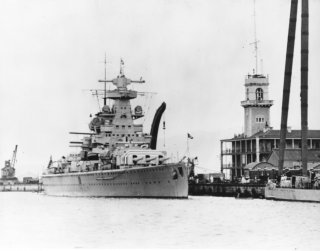‘Pocket Battleships’ Helped Germany Beat Naval Disarmament
The most famous—or even infamous—of the three pocket battleships is arguably Admiral Graf Spee.
Here’s What You Need to Remember: While Graf Spee inflicted heavy damage on the British ships, she was damaged in the action and was forced into the port of Montevideo. Rather than let the ship be captured, and unable to make for the open sea, Captain Hans Wilhelm Langsdorff ordered the pocket battleship scuttled. Three days later he committed suicide in Buenos Aires, Argentina.
When Germany began to rearm its military, it initially sought to circumvent the restrictions that were placed upon it by the Treaty of Versailles that was imposed on the nation following the First World War. While it was the Nazi regime that is often noted for this use of subterfuge, it actually began during the Weimar Republic as noted by the building of the Deutschland-class of cruisers.
These warships also broke the rules imposed on Germany by the Washington Treaty, and while still relatively small in size, the Deutschland-class were well armored and carried the type of armament traditionally only seen on battleships. Built for the Reichsmarine—the German Navy during the Weimar Republic and the first two years of Nazi Germany—between 1929 and 1936, these heavily armed cruisers displaced 10,600 to 12,340 long tons. That was larger than the 10,000 long tons of the Washington Treaty, but used welding in their construction as well as diesel-centric propulsion as weight-saving measures.
However, it was the guns that set these three ships apart from the other cruisers of the era. Each carried six 11-inch guns in their primary battery, weapons that were typically only found on battleships, and this fact led to the vessels being called “Pocket Battleships” by British observers. It was believed that this new class of warships would hold its own against a "proper" battleship, as a "treaty" cruiser would be out-gunned in such an engagement.
With the speed of a cruiser and the firepower of a capital ship, the pocket battleships seemed ideally suited to a specific purpose: commerce raiding. Yet, these vessels were actually first combat tested in a role reserved for true battleships of the era, shore bombardment. Deutschland and Admiral Scheer, the first of the two pocket battleships built for the German Navy, were deployed overseas during the Spanish Civil War, during which Deutschland came under attack from Spanish Republican aircraft including a pair of Soviet-built SB-2 bombers. In response, Hitler ordered Admiral Scheer to bombard of the port of Almería.
At the outbreak of World War II, all three pocket battleships were deployed as commerce raiders, while Deutschland—soon renamed Lützow—took part in the German invasion of Norway in 1940. Damaged by a British submarine, she was repaired and then again was engaged against merchant shipping and allied convoys. Damaged at the end of the war, she was used as a gun battery against the Soviet attack on Germany.
Admiral Scheer spent much of the war in commerce raids and even made a brief foray into the Indian Ocean. Sinking 113,223 gross register tons (GRT) of shipping, she proved to be the most accomplished capital ship surface raider of the war. She was used as a training ship and then to support ground operations against the Soviets. She was struck by mobile bombs during a British air raid on Kiel in April 1945 and capsized. Her wreck is buried near the current port facilities in the city.
The most famous—or even infamous—of the three pocket battleships is arguably Admiral Graf Spee, the last of the class to be built. She was operating as a commerce raider in the South Atlantic at the start of the war, and between September and December 1939 sank nine ships totaling 50,089 GRT. In response, the British and French navies sent a task force and she confronted three British cruisers off the coast of Uruguay during the Battle of the River Plate on December 13, 1939. It was the first naval battle of World War II.
While Graf Spee inflicted heavy damage on the British ships, she was damaged in the action and was forced into the port of Montevideo. Rather than let the ship be captured, and unable to make for the open sea, Captain Hans Wilhelm Langsdorff ordered the pocket battleship scuttled. Three days later he committed suicide in Buenos Aires, Argentina.
Peter Suciu is a Michigan-based writer who has contributed to more than four dozen magazines, newspapers and websites. He regularly writes about military small arms, and is the author of several books on military headgear including A Gallery of Military Headdress, which is available on Amazon.com.
This article is being republished due to reader interest.
Image: Wikimedia Commons.

